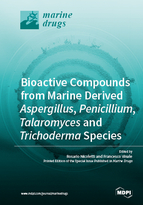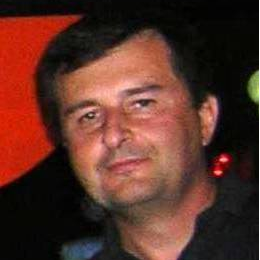Bioactive Compounds from Marine-Derived Aspergillus, Penicillium, Talaromyces and Trichoderma Species
A special issue of Marine Drugs (ISSN 1660-3397).
Deadline for manuscript submissions: closed (30 June 2018) | Viewed by 53513
Special Issue Editors
2. Department of Agricultural Sciences, University of Naples Federico II, 80055 Portici, Italy
Interests: endophytes; plant pathogens; entomopathogens; biocontrol; bioactive fungal products; marine fungi
Special Issues, Collections and Topics in MDPI journals
2. Istituto per la Protezione Sostenibile delle Piante, Consiglio Nazionale delle Ricerche (IPSP-CNR), 80055 Portici (NA), Italy
Interests: biological control; Trichoderma; secondary metabolites; metabolite characterization; plant pathogens
Special Issues, Collections and Topics in MDPI journals
Special Issue Information
Dear Colleagues,
The importance of bioactive natural compounds in pharmacology and other biotechnological fields has stimulated the scientific community to explore new environmental contexts and the associated microbial diversity. As the largest frontier in biological discovery, the sea represents a significant source of organisms producing novel secondary metabolites with interesting bioactivities. Within this biological material, fungi have received an increasing consideration, both for their pervasive occurrence in several habitats and for their widespread aptitude to develop symbiotic associations with higher organisms. In many cases, fungal strains have been reported as the real producers of drugs originally extracted from marine plants and animals. The constantly-increasing number of marine-derived fungi yielding valuable bioactive products makes it now appropriate to consider more organized forms of presentation to the recipient audience.
This Special Issue of Marine Drugs entitled “Bioactive Compounds from Marine-Derived Aspergillus, Penicillium, Talaromyces and Trichoderma Species” is specifically focused on a few genera of ascomycetous fungi, which are quite widespread in marine contexts, and are particularly inclined to establish symbiotic relationships. Full research papers, short notes and review articles reporting the finding and the characterization of products showing antibiotic, antitumor, antiviral, insecticidal, antimalarial, antifouling, antioxidant, plant growth-promoting and/or resistance-inducing, as well as other less exploited activities, are invited for this editorial project.
Dr. Rosario Nicoletti
Dr. Francesco Vinale
Guest Editors
Manuscript Submission Information
Manuscripts should be submitted online at www.mdpi.com by registering and logging in to this website. Once you are registered, click here to go to the submission form. Manuscripts can be submitted until the deadline. All submissions that pass pre-check are peer-reviewed. Accepted papers will be published continuously in the journal (as soon as accepted) and will be listed together on the special issue website. Research articles, review articles as well as short communications are invited. For planned papers, a title and short abstract (about 100 words) can be sent to the Editorial Office for announcement on this website.
Submitted manuscripts should not have been published previously, nor be under consideration for publication elsewhere (except conference proceedings papers). All manuscripts are thoroughly refereed through a single-blind peer-review process. A guide for authors and other relevant information for submission of manuscripts is available on the Instructions for Authors page. Marine Drugs is an international peer-reviewed open access monthly journal published by MDPI.
Please visit the Instructions for Authors page before submitting a manuscript. The Article Processing Charge (APC) for publication in this open access journal is 2900 CHF (Swiss Francs). Submitted papers should be well formatted and use good English. Authors may use MDPI's English editing service prior to publication or during author revisions.
Keywords
- Aspergillus
- bioactive products
- drug discovery
- fungal diversity
- marine-derived fungi
- Penicillium
- symbiosis
- Talaromyces
- Trichoderma








